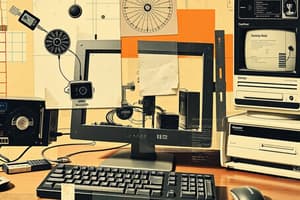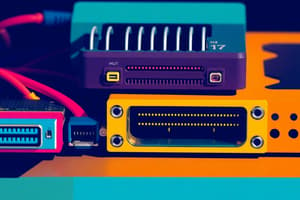Podcast
Questions and Answers
Which of the following storage types is considered volatile, meaning its data is lost when the power is turned off?
Which of the following storage types is considered volatile, meaning its data is lost when the power is turned off?
- Secondary Storage
- NAS
- Primary Storage (correct)
- GPU
What is the primary function of a Graphics Processing Unit (GPU)?
What is the primary function of a Graphics Processing Unit (GPU)?
- Controlling the flow of data between different components.
- Processing and rendering visual information for display. (correct)
- Managing user interactions with the operating system.
- Storing data for long-term access.
Which of the following is NOT considered a primary storage component?
Which of the following is NOT considered a primary storage component?
- RAM (Random Access Memory)
- Cache Memory
- ROM (Read-Only Memory)
- Hard Disk Drive (correct)
Which of the following BEST describes the role of a Network Attached Storage (NAS) device?
Which of the following BEST describes the role of a Network Attached Storage (NAS) device?
What type of storage device is typically used as the primary storage for system files and applications to be accessible to the main processing unit?
What type of storage device is typically used as the primary storage for system files and applications to be accessible to the main processing unit?
Flashcards
Input Devices
Input Devices
Devices that allow users to enter data into a computer.
Output Devices
Output Devices
Devices that convey information from a computer to users.
Volatile vs Non-volatile Storage
Volatile vs Non-volatile Storage
Volatile storage loses data when powered off; non-volatile retains data.
GPU
GPU
Signup and view all the flashcards
Primary vs Secondary Storage
Primary vs Secondary Storage
Signup and view all the flashcards
Study Notes
Input Devices
- Input devices allow users to enter data into a computer system.
- Examples include keyboards, mice, touchscreens, and scanners.
Output Devices
- Output devices display or present data processed by a computer system.
- Examples include monitors, printers, and speakers.
Processing
- Processing involves the manipulation of data according to instructions.
- Central Processing Unit (CPU) is the primary component responsible for processing.
Monitor Maintenance
- Avoid physical damage to the screen.
- Keep the monitor clean and free from dust and debris.
- Don't place objects on the monitor that could cause damage.
- Keep the environment cool and avoid extreme temperatures.
Mouse Maintenance
- Keep the mouse clean and free from dust.
- Replace the mouse if the scroll wheel is malfunctioning.
- Ensure the mouse is properly connected to the computer.
Software Maintenance
- Keep software updated to fix bugs and enhance functionality.
- Regularly back up data.
- Use antivirus software.
- Avoid installing suspicious software.
Primary Storage (RAM)
- Primary storage is volatile memory.
- It stores data that is currently being used.
- It looses data when the power is off.
Secondary Storage
- Secondary storage is non-volatile memory.
- It stores data for long-term use.
- Examples include hard drives, SSDs, and flash drives.
GPU (Graphics Processing Unit)
- The GPU is a specialized electronic circuit designed to rapidly manipulate and alter memory to accelerate the creation of images in a frame buffer intended for output to a display.
CPU (Central Processing Unit)
- The CPU is the primary component of the computer responsible for processing instructions.
- It controls all functions of the computer.
Roles of Storage Devices
- Storage devices store and retrieve data.
- They enable long-term data retention.
- They often provide a way to share data on a network.
NAS (Network Attached Storage)
- NAS is a specialized storage device that is networked to a computer system for storage and retrieval of data.
- Often used to store and share files.
Volatile vs. Non-Volatile
- Volatile storage loses data when the power is turned off. RAM is volatile.
- Non-volatile storage retains data even when the power is off. Hard drives and SSDs are non-volatile.
Components of a Computer System
- Input Devices
- Output Devices
- Processing Unit
- Storage Devices
Elements of a Computer System
- Hardware: Physical components
- Software: Instructions for the hardware
- Data: Processed information
- People: Users and operators
Evolution of Computers
- Computers have become smaller, faster, and more powerful over time.
- Early computers were large and expensive, but technology has enabled smaller, more affordable options.
Input
- Information entered into the computer
Output
- Data processed and presented to the user
Storage
- Data is stored for later use
Process
- Manipulation of data according to instructions.
Basic Parts of a Computer System
- Input, processing, output, storage
Types of Storage
- Primary Storage (RAM)
- Secondary Storage (Hard drives, SSDs, etc)
Studying That Suits You
Use AI to generate personalized quizzes and flashcards to suit your learning preferences.




